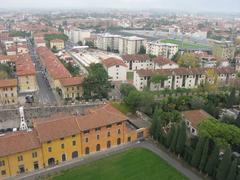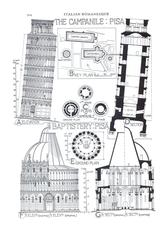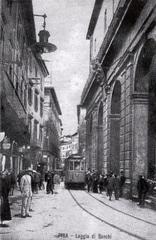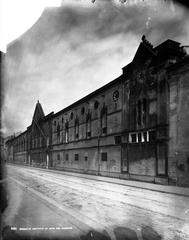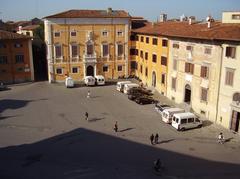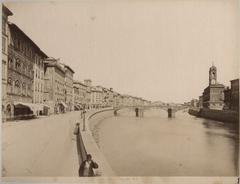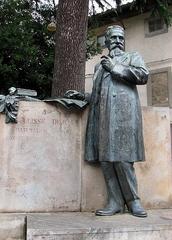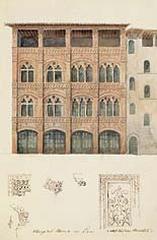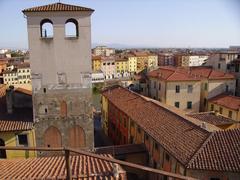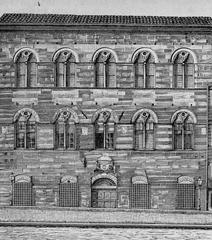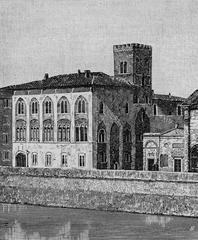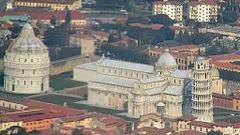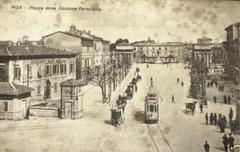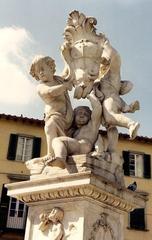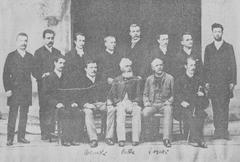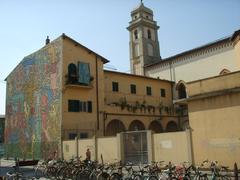Visiting Hours and Tickets for Bagni di Nerone, Pisa
Date: 24/07/2024
Introduction
Pisa, a city renowned for its architectural marvels, is home to the ancient thermal baths known as Bagni di Nerone or Baths of Nero. Nestled at the end of Borgo Largo, these baths date back to the 1st century AD and serve as a testament to Roman engineering prowess and cultural heritage. The Roman baths were not merely places for bathing but also social hubs that included gymnasiums, reflecting the Roman emphasis on physical fitness and public life. With water supplied via a sophisticated aqueduct from San Giuliano Terme, the Bagni di Nerone showcases the advanced engineering skills of the Romans (source). This comprehensive guide aims to enrich your visit by delving into the site’s historical, architectural, and cultural significance, alongside practical visitor information and travel tips.
Table of Contents
- [Introduction](#introductionintroduction)
- [History and Significance of Bagni di Nerone, Pisa, Italy](#history-and-significance-of-bagni-di-nerone-pisa-italyhistory-and-significance-of-bagni-di-nerone-pisa-italy)
- [Roman Origins and Architectural Marvel](#roman-origins-and-architectural-marvelroman-origins-and-architectural-marvel)
- [Structural Features](#structural-featuresstructural-features)
- [Medieval and Renaissance Transformations](#medieval-and-renaissance-transformationsmedieval-and-renaissance-transformations)
- [20th Century and Modern Use](#20th-century-and-modern-use20th-century-and-modern-use)
- [Archaeological Significance](#archaeological-significancearchaeological-significance)
- [Cultural Impact](#cultural-impactcultural-impact)
- [Visitor Information](#visitor-informationvisitor-information)
- [Opening Hours and Best Time to Visit](#opening-hours-and-best-time-to-visitopening-hours-and-best-time-to-visit)
- [Admission Fees](#admission-feesadmission-fees)
- [Guided Tours](#guided-toursguided-tours)
- [Accessibility](#accessibilityaccessibility)
- [Photography](#photographyphotography)
- [Nearby Attractions](#nearby-attractionsnearby-attractions)
- [Travel Tips](#travel-tipstravel-tips)
- [FAQ](#faqfaq)
- [Conclusion](#conclusionconclusion)
History and Significance of Bagni di Nerone, Pisa, Italy
Roman Origins and Architectural Marvel
The Bagni di Nerone, or Baths of Nero, are a testament to Pisa’s rich Roman heritage. These ancient thermal baths, located at the end of Borgo Largo, date back to the 1st century AD. The baths were part of a larger Roman complex that included a gymnasium, reflecting the Roman emphasis on physical fitness and public bathing as a social activity. The water for these baths was supplied via a Roman aqueduct from San Giuliano Terme, showcasing the advanced engineering skills of the Romans.
Structural Features
One of the most striking features of the Bagni di Nerone is the hot water bath, which is octagonal in shape and topped with a perforated dome roof. This architectural design not only served a functional purpose but also added to the aesthetic appeal of the structure. The remains of the gymnasium next to the baths further highlight the complex’s multifunctional use. Although visitors cannot view the excavations up close, the site is visible from behind a fence, allowing for a glimpse into ancient Roman life.
Medieval and Renaissance Transformations
The Bagni di Nerone continued to be a significant site through the medieval and Renaissance periods. During these times, Pisa was a flourishing maritime republic, and the baths remained a symbol of the city’s historical continuity. The structure underwent various modifications and restorations, adapting to the changing needs and architectural styles of the times. These transformations reflect the dynamic history of Pisa and its ability to preserve and repurpose its historical landmarks.
20th Century and Modern Use
In the 20th century, the Bagni di Nerone saw a resurgence in interest, particularly during the Second World War. The site was repurposed as an air-raid shelter, rediscovering its military significance. Post-war, the baths were divided into separate properties and sold to private individuals. This period also saw the addition of modern structures like a bar and a garage, which were later removed during restoration efforts to preserve the historical integrity of the site.
Archaeological Significance
The Bagni di Nerone is not just a historical site but also an important archaeological landmark. The excavations have provided valuable insights into Roman engineering, urban planning, and daily life. The site’s preservation allows historians and archaeologists to study the evolution of public bathing practices and the architectural advancements of the Roman era. The explanatory panels installed at the site offer visitors detailed information about the historical and constructive phases of the baths, enhancing their understanding of this ancient marvel.
Cultural Impact
The Bagni di Nerone holds a special place in the cultural landscape of Pisa. It serves as a reminder of the city’s Roman past and its continuous evolution through the centuries. The site is a popular tourist attraction, drawing visitors interested in history, architecture, and archaeology. The baths are also a focal point for educational tours, providing a tangible connection to the ancient world for students and scholars alike.
Visitor Information
Opening Hours and Best Time to Visit
The Bagni di Nerone is open daily from 9 AM to 7 PM. The best time to visit is during the spring and fall when the weather is pleasant, and the tourist crowds are smaller.
Admission Fees
Tickets can be purchased at the entrance for €5. Currently, there is no additional admission fee, but donations are appreciated for site maintenance and preservation.
Guided Tours
Guided tours are available upon request. Local guides provide fascinating insights into the history and architecture of the baths, offering a richer experience. Some tours may also include visits to other nearby historical sites, offering a comprehensive overview of Pisa’s historical sites.
Accessibility
The site is partially accessible to visitors with mobility issues. The terrain around the ruins can be uneven, and some areas may not be wheelchair-friendly. Comfortable walking shoes are recommended, and it’s advisable to contact the site in advance for specific accessibility options.
Photography
Photography is allowed at Bagni di Nerone, offering numerous picturesque spots. However, be respectful of the historical nature of the site. Avoid climbing on the ruins and disturbing the area. Drones are generally not permitted unless special permission is obtained in advance.
Nearby Attractions
While visiting the Bagni di Nerone, make sure to explore nearby attractions such as the Leaning Tower of Pisa and the Piazza dei Miracoli. These iconic landmarks provide a deeper understanding of Pisa’s historical and cultural significance. Several amenities near Bagni di Nerone enhance your visit. Cafes, restaurants, and shops are within walking distance, offering opportunities to enjoy local cuisine and purchase souvenirs. Public restrooms are also available nearby, though they may require a small fee.
Travel Tips
- Best Time to Visit: The best time to visit the Bagni di Nerone is during the spring (April to June) and fall (September to October) when the weather is pleasant, and the tourist crowds are smaller.
- Accessibility: The site is easily accessible from the pedestrian streets of Borgo Stretto and Borgo Largo. However, note that the excavations cannot be viewed up close but are visible from behind a fence.
- What to Bring: Comfortable walking shoes, a camera for capturing the historical marvels, and a guidebook for additional context.
- Safety Tips: While Bagni di Nerone is generally safe, standard precautions are advisable. Keep an eye on your belongings, especially in crowded areas, and be aware of your surroundings. The ruins can be slippery, especially after rain, so walk carefully.
- Weather Considerations: Pisa experiences a Mediterranean climate with hot summers and mild winters. During summer, visit early in the morning or late in the afternoon to avoid the midday heat. Always carry water, wear sunscreen, and bring a hat to protect yourself from the sun.
- Language and Cultural Etiquette: While Italian is the primary language in Pisa, many locals in the tourism industry speak English. Learning a few basic Italian phrases can enhance your experience and show respect for the local culture. Phrases like “Grazie” (Thank you), “Per favore” (Please), and “Dove si trova…?” (Where is…?) can be very helpful.
FAQ
- Q: What are the visiting hours for Bagni di Nerone?
- A: The site is open daily from 9 AM to 7 PM.
- Q: How much are the tickets for Bagni di Nerone?
- A: Tickets cost €5 and can be purchased at the entrance.
- Q: Are guided tours available?
- A: Yes, guided tours are available upon request.
Conclusion
In conclusion, a visit to Bagni di Nerone offers a unique glimpse into Pisa’s Roman past, celebrating the architectural ingenuity and cultural richness of the era. From the octagonal hot water bath to the remains of the gymnasium, the site is a living museum of ancient engineering and social life. As Pisa evolved through the medieval and Renaissance periods, so did the baths, adapting and transforming with the times. Today, the restored Bagni di Nerone stands as a symbol of historical continuity and cultural importance, attracting history enthusiasts and casual tourists alike. With accessible visiting hours, affordable tickets, and a plethora of nearby attractions like the Leaning Tower of Pisa, this site promises an enriching and memorable experience. For the latest updates and detailed visitor information, consult the Pisa Tourism Website. Downloading travel apps like Audiala can also enhance your visit with real-time tips and updates (source).
References
- Pisa Tourism Website (source)
